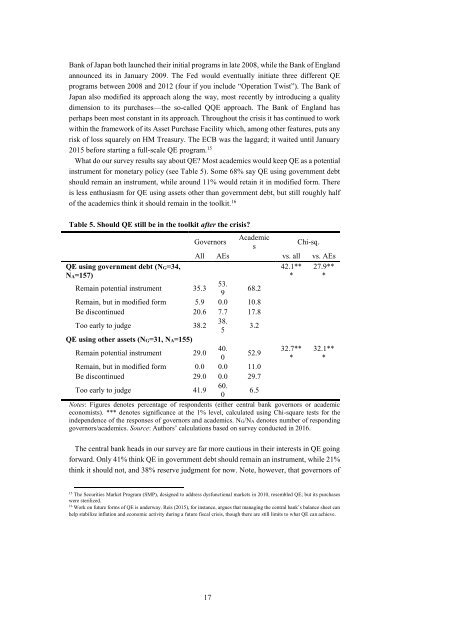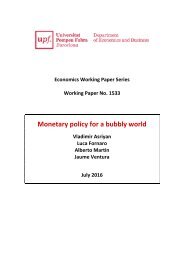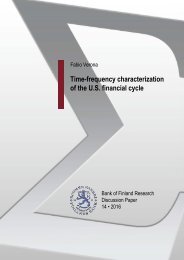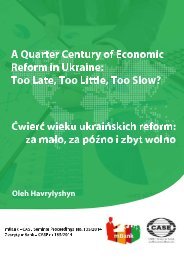Necessity as the mother of invention monetary policy after the crisis
n?u=RePEc:dnb:dnbwpp:525&r=mac
n?u=RePEc:dnb:dnbwpp:525&r=mac
Create successful ePaper yourself
Turn your PDF publications into a flip-book with our unique Google optimized e-Paper software.
Bank <strong>of</strong> Japan both launched <strong>the</strong>ir initial programs in late 2008, while <strong>the</strong> Bank <strong>of</strong> England<br />
announced its in January 2009. The Fed would eventually initiate three different QE<br />
programs between 2008 and 2012 (four if you include “Operation Twist”). The Bank <strong>of</strong><br />
Japan also modified its approach along <strong>the</strong> way, most recently by introducing a quality<br />
dimension to its purch<strong>as</strong>es—<strong>the</strong> so-called QQE approach. The Bank <strong>of</strong> England h<strong>as</strong><br />
perhaps been most constant in its approach. Throughout <strong>the</strong> <strong>crisis</strong> it h<strong>as</strong> continued to work<br />
within <strong>the</strong> framework <strong>of</strong> its Asset Purch<strong>as</strong>e Facility which, among o<strong>the</strong>r features, puts any<br />
risk <strong>of</strong> loss squarely on HM Tre<strong>as</strong>ury. The ECB w<strong>as</strong> <strong>the</strong> laggard; it waited until January<br />
2015 before starting a full-scale QE program. 15<br />
What do our survey results say about QE? Most academics would keep QE <strong>as</strong> a potential<br />
instrument for <strong>monetary</strong> <strong>policy</strong> (see Table 5). Some 68% say QE using government debt<br />
should remain an instrument, while around 11% would retain it in modified form. There<br />
is less enthusi<strong>as</strong>m for QE using <strong>as</strong>sets o<strong>the</strong>r than government debt, but still roughly half<br />
<strong>of</strong> <strong>the</strong> academics think it should remain in <strong>the</strong> toolkit. 16<br />
Table 5. Should QE still be in <strong>the</strong> toolkit <strong>after</strong> <strong>the</strong> <strong>crisis</strong>?<br />
QE using government debt (NG=34,<br />
NA=157)<br />
Remain potential instrument 35.3<br />
Remain, but in modified form 5.9 0.0 10.8<br />
Be discontinued 20.6 7.7 17.8<br />
Too early to judge 38.2<br />
38.<br />
5<br />
3.2<br />
QE using o<strong>the</strong>r <strong>as</strong>sets (NG=31, NA=155)<br />
Remain potential instrument 29.0<br />
40.<br />
0<br />
52.9<br />
Remain, but in modified form 0.0 0.0 11.0<br />
Be discontinued 29.0 0.0 29.7<br />
Too early to judge 41.9<br />
60.<br />
0<br />
6.5<br />
Governors<br />
Academic<br />
s<br />
Chi-sq.<br />
All AEs vs. all vs. AEs<br />
42.1** 27.9**<br />
* *<br />
53.<br />
9<br />
68.2<br />
32.7**<br />
*<br />
32.1**<br />
*<br />
Notes: Figures denotes percentage <strong>of</strong> respondents (ei<strong>the</strong>r central bank governors or academic<br />
economists). *** denotes significance at <strong>the</strong> 1% level, calculated using Chi-square tests for <strong>the</strong><br />
independence <strong>of</strong> <strong>the</strong> responses <strong>of</strong> governors and academics. NG/NA denotes number <strong>of</strong> responding<br />
governors/academics. Source: Authors’ calculations b<strong>as</strong>ed on survey conducted in 2016.<br />
The central bank heads in our survey are far more cautious in <strong>the</strong>ir interests in QE going<br />
forward. Only 41% think QE in government debt should remain an instrument, while 21%<br />
think it should not, and 38% reserve judgment for now. Note, however, that governors <strong>of</strong><br />
15<br />
The Securities Market Program (SMP), designed to address dysfunctional markets in 2010, resembled QE; but its purch<strong>as</strong>es<br />
were sterilized.<br />
16<br />
Work on future forms <strong>of</strong> QE is underway. Reis (2015), for instance, argues that managing <strong>the</strong> central bank’s balance sheet can<br />
help stabilize inflation and economic activity during a future fiscal <strong>crisis</strong>, though <strong>the</strong>re are still limits to what QE can achieve.<br />
17








